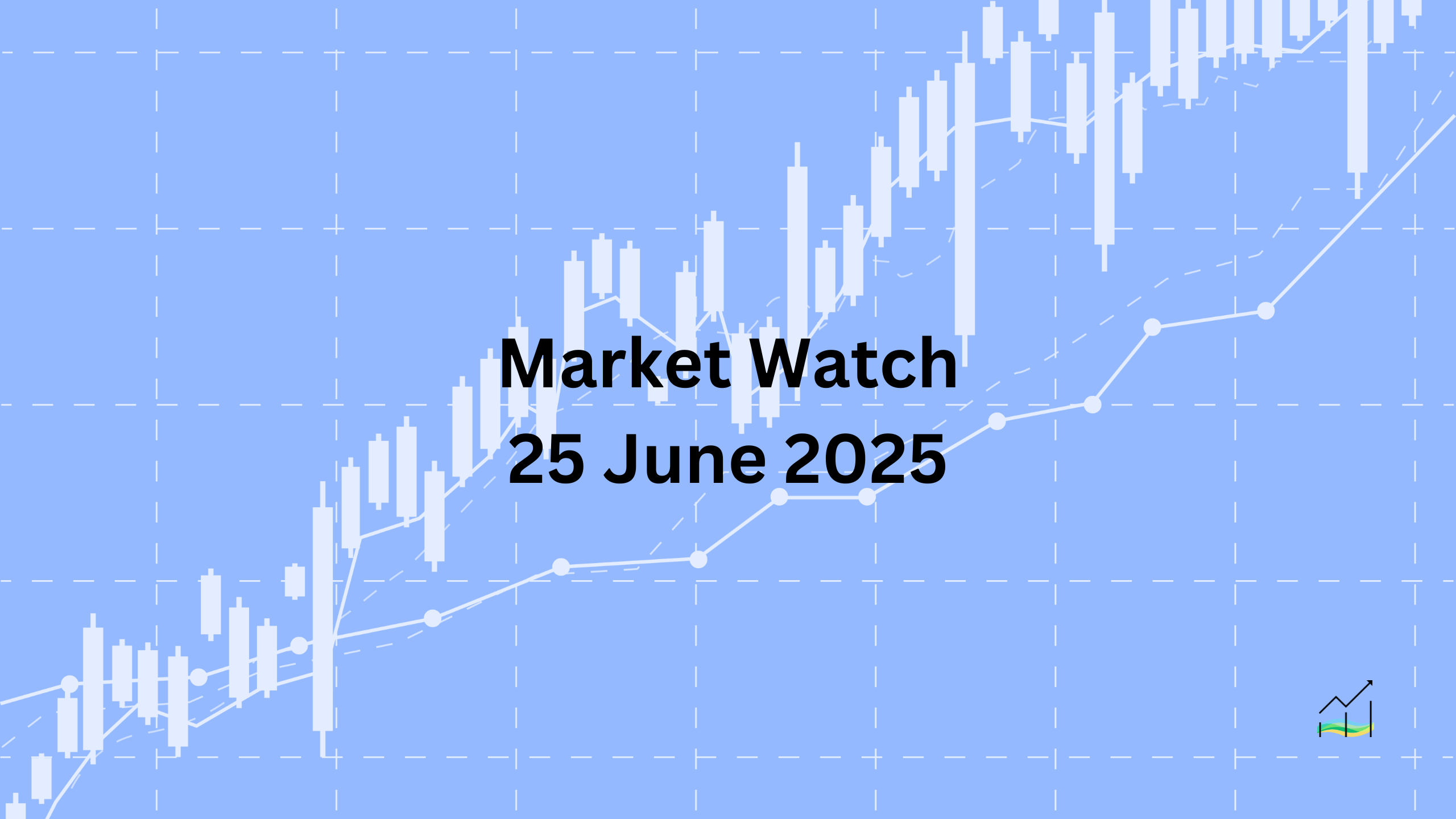25/06/2025 Market Watch

Geopolitical Tensions Ease, Dollar Recovers
Key Takeaways:
- Global markets stabilize following volatility early in the week.
- US-Iran tensions ease amid a holding ceasefire.
- Dollar strengthens modestly after recent lows; mixed performance among G10 currencies.
- Asian equities continue their rally; European and US markets steadier.
- Oil prices rebound slightly after significant drops; clarity needed on US stance regarding Iranian oil sanctions.
Following a turbulent start, global capital markets are showing signs of stabilization, largely driven by the apparent holding of the ceasefire between Israel and Iran. Market volatility had increased significantly earlier this week amid heightened geopolitical uncertainty, particularly relating to the effectiveness of recent US strikes against Iran's nuclear program. Although the US administration disputes claims that their actions offered only limited delays to Iran's nuclear ambitions, tensions have since eased.
The US dollar, which faced sharp declines and recorded annual lows against major currencies such as the euro and sterling earlier this week, is now trading with renewed firmness. While the Australian and New Zealand dollars have edged modestly higher, other G10 currencies, notably yesterday’s stronger performers like the Japanese yen and the Swiss franc, are experiencing moderate declines today.
Emerging market currencies present a mixed picture, with Central European currencies mostly weaker, whereas currencies in the Asia-Pacific region have shown moderate strength, apart from the Chinese yuan, which is slightly weaker.
Asian equity markets have maintained their positive momentum, with major indices in Hong Kong, China, and Taiwan gaining more than 1%. European markets, after yesterday's solid gains, have stabilized, trading near flat. US equity futures also point to a steady or slightly stronger open.
Benchmark 10-year bond yields have generally softened. Yields in Japan, Australia, and New Zealand have decreased between 2.5 and 4.5 basis points, while European yields are slightly lower, though German Bunds remain under pressure due to anticipated supply. The US 10-year Treasury yield remains stable around 4.29%.
Commodities have seen significant volatility, particularly in oil prices. After sharp declines over the past two days, with August WTI oil dropping over 13%, prices have rebounded modestly, reclaiming levels above $65 per barrel. However, uncertainty remains around US policy on Iranian oil sanctions, particularly following President Trump's comments suggesting openness towards Chinese purchases of Iranian crude, though sanctions officially remain intact according to White House clarifications. Gold prices remain stable today after absorbing a notable drop yesterday.
United States of America
Overview
The US dollar experienced aggressive selling amid improved global risk sentiment stemming from the fragile ceasefire in the Israel-Iran conflict. The Dollar Index, reflecting the dollar’s overall strength against major peers, dropped sharply and approached its three-year low recorded earlier this month near the 97.60 mark. Currently, the index is consolidating within a narrow trading range of roughly 97.80 to 98.10, following significant technical signals, including a key downside reversal earlier in the week.
Attention remains on Federal Reserve Chair Jerome Powell, who is delivering the second part of his semiannual testimony before Congress today. Powell's core message aligns closely with his comments made after last week's Federal Open Market Committee (FOMC) meeting, reiterating the Fed’s cautious approach in light of tariff-related inflation risks. Powell explicitly connected tariffs with higher inflation expectations, noting that without these pressures, the Fed would likely continue easing monetary policy.
Despite the dovish commentary from two Fed governors, suggesting openness to another rate cut by late July, markets remain skeptical. Current Fed funds futures suggest only about a 20% chance of another rate cut, down from around 28% implied by market pricing at the end of last month.
On the economic data front, markets await the release of US new home sales. Following an exceptionally strong performance in April, new home sales are expected to moderate significantly in May.
Economic Drivers
- Fragile geopolitical calm (Israel-Iran ceasefire) boosting risk sentiment.
- Fed Chair Powell explicitly linking tariffs to rising inflation expectations.
- Skepticism in Fed funds futures markets regarding further rate cuts.
Data and Events
- 25 June 2025: Fed Chair Powell Testifies.
- 25 June 2025: New Home Sales.
Price Action
- Dollar Index consolidating narrowly between 97.80 and 98.10.
- Technical significance from recent gap lower and key downside reversal.
Key Points:
- US dollar sharply lower amid easing geopolitical tensions.
- Powell reiterates cautious stance on inflation and tariffs.
- Fed fund futures show low expectation of further rate cuts.
- New home sales expected to decline after strong prior month.
- Technical indicators suggest continued caution in dollar trading.
Australia
Overview
The Australian dollar staged a significant recovery after being heavily sold to a six-week low earlier in the week, briefly falling below $0.6375. The currency quickly rebounded to nearly $0.6520 yesterday, approaching the seven-month high near $0.6550 set earlier this month. This high marked an important retracement point from previous highs last September to the low in April.
Today, however, the Australian dollar's recovery momentum has stalled, and it is currently consolidating within a narrow trading range, holding between approximately $0.6490 and $0.6505.
Australia's inflation moderated notably in May, with the Consumer Price Index (CPI) dropping to 2.1% from 2.4% recorded in April, matching last year's lowest level. Core inflation, measured by the trimmed mean CPI, also eased significantly from 2.8% to 2.4%.
Following the moderation in inflation, market expectations for a rate cut by the Reserve Bank of Australia (RBA) at its upcoming meeting on July 8 have solidified. The futures market is now pricing in nearly a 90% chance of a rate cut, up from around 80% earlier this month.
Economic Drivers
- Moderate inflation data, reducing pressure on the RBA.
- High market confidence in an upcoming interest rate cut by the RBA.
- Improving market sentiment following easing geopolitical risks globally.
Data and Events
- 25 June 2025: CPI.
Price Action
- Australian dollar consolidating narrowly between $0.6490 and $0.6505.
- Key resistance near recent seven-month high around $0.6550.
- Support established following sharp bounce from six-week low near $0.6375.
Key Points:
- Australian dollar sharply recovers after six-week lows.
- Inflation easing significantly in May.
- High market expectations for RBA rate cut.
- Current price consolidation following recent volatility.
Canada
Overview
The Canadian dollar made a modest gain against the US dollar yesterday, outperforming only slightly compared to other major currencies. The currency's recent movements remain closely linked with oil prices, reflecting a shift this month from a previously inverse relationship to a mildly positive correlation with West Texas Intermediate (WTI) crude.
After hitting the highest level for June near CAD1.3800 earlier this week, the US dollar dropped to a four-day low around CAD1.3680 yesterday, before rebounding towards CAD1.3725 later in the North American session. Trading today remains relatively quiet, with the US dollar confined to a narrow range, approximately between CAD1.3715 and CAD1.3735.
Inflation data for May was reported in line with market expectations, with Canada's headline Consumer Price Index (CPI) remaining steady at 1.7% year-over-year. Meanwhile, core inflation slightly moderated, edging down by 0.1% to 3.0%. Market expectations for an interest rate cut remain strong, with the swaps market nearly fully pricing in a cut by the Bank of Canada at its October meeting.
Economic Drivers
- Stability in Canadian inflation data, aligned with expectations.
- Persistent market expectations for an October rate cut.
- Influence of oil price movements (WTI) on the Canadian dollar.
Data and Events
No major economic releases are scheduled today.
Price Action
- US dollar consolidating in a tight range, approximately between CAD1.3715 and CAD1.3735.
- Immediate resistance seen near the recent monthly high at CAD1.3800.
- Near-term support identified at yesterday’s low near CAD1.3680.
Key Points:
- Canadian dollar slightly stronger after recent volatility.
- Inflation stable, core measures easing modestly.
- Market highly anticipates an October interest rate cut.
- Canadian dollar remains sensitive to oil price dynamics.
Europe
Overview
The euro strengthened to a fresh three-year high yesterday, briefly approaching the $1.1640 mark, and successfully settled above the critical $1.1600 level after several attempts earlier in the month. This confirms strong bullish momentum for the currency, pointing towards a potential further rise targeting the $1.1700 to $1.1720 zone.
On the fiscal front, Germany revealed plans to significantly increase borrowing for the third quarter of 2025, amounting to 118.5 billion euros. This represents nearly a 20% rise compared to initial expectations. The increased funding is primarily aimed at enhancing public infrastructure and strengthening national defense capabilities.
In economic data, the eurozone showed signs of recovery in the automotive sector, with auto registrations improving in May, posting a modest 1.6% increase year-over-year. This recovery contrasts with the US auto market, where sales declined approximately 1.6% year-over-year for the same month, although year-to-date figures in the US are still elevated due to anticipated tariff effects accelerating vehicle purchases.
Economic Drivers
- Significant increase in German government spending plans, especially on infrastructure and defense.
- Improvement in eurozone automotive sector, signaling consumer confidence recovery.
- Relative strength compared to recent softness in US auto market figures.
Data and Events
No major economic releases are scheduled today.
Price Action
- Euro consolidating gains between $1.1590 and $1.1630 following recent highs.
- Immediate resistance identified near $1.1640, with next significant target at $1.1700-1.1720.
- Key support now clearly established at the $1.1590 level.
Key Points:
- Euro firmly establishes above critical $1.1600 level.
- German fiscal expansion announced for Q3 2025.
- Eurozone auto sector showing signs of recovery.
- Further bullish momentum anticipated with resistance around $1.1700 area.
Japan
Overview
The US dollar experienced significant weakness against the Japanese yen recently, driven mainly by a notable decline in US Treasury yields. Specifically, the US 10-year yield has decreased by approximately 10 basis points over the past three sessions, with half of this decline occurring yesterday alone. Consequently, the dollar erased gains accumulated over the preceding days, falling by nearly 1.5%.
Despite briefly overshooting important technical retracement levels, the dollar found solid support near its 20-day moving average at around JPY145.50, recovering modestly to around JPY145.70 during today’s European session.
On the economic front, Japan reported a slight moderation in May’s service producer price index, easing to 3.3% year-over-year, from a revised 3.4% in April. Nevertheless, this remains elevated compared to the 2.7% recorded a year earlier, reflecting ongoing price pressures in Japan’s service sector.
Bank of Japan (BOJ) policymaker Tamura, known for his hawkish views, recently indicated the possible necessity of interest rate hikes despite prevailing economic uncertainties. Market expectations remain cautious, however, with the swaps market currently pricing less than a 5% probability for a July rate hike. Overall market pricing implies around 12-13 basis points of tightening by year-end, down from earlier expectations in early June.
Economic Drivers
- Declining US Treasury yields affecting currency flows.
- Persistent inflationary pressure in Japan's service sector.
- Hawkish commentary from BOJ member Tamura, highlighting the possibility of future rate hikes despite market skepticism.
Data and Events
No major economic releases are scheduled today.
Price Action
- US dollar found strong support at approximately JPY145.50 (20-day moving average).
- Consolidating currently near JPY145.70 after notable declines.
- Immediate technical resistance around recent highs near JPY146.00; support remains near yesterday's low around JPY145.50.
Key Points:
- Significant decline in US yields driving yen strength.
- BOJ maintains cautious stance despite hawkish signals.
- Market remains doubtful about near-term rate hikes.
- Technical support holding at key moving average levels.
© 2025 SKONE Enterprise (003319453-V). All rights reserved.
The content on this site is for informational purposes only and does not constitute financial advice.


